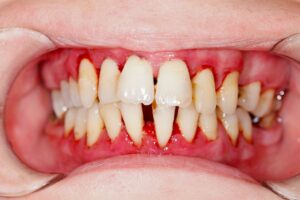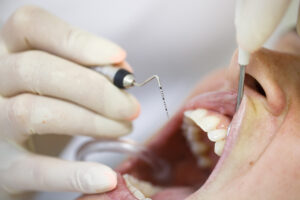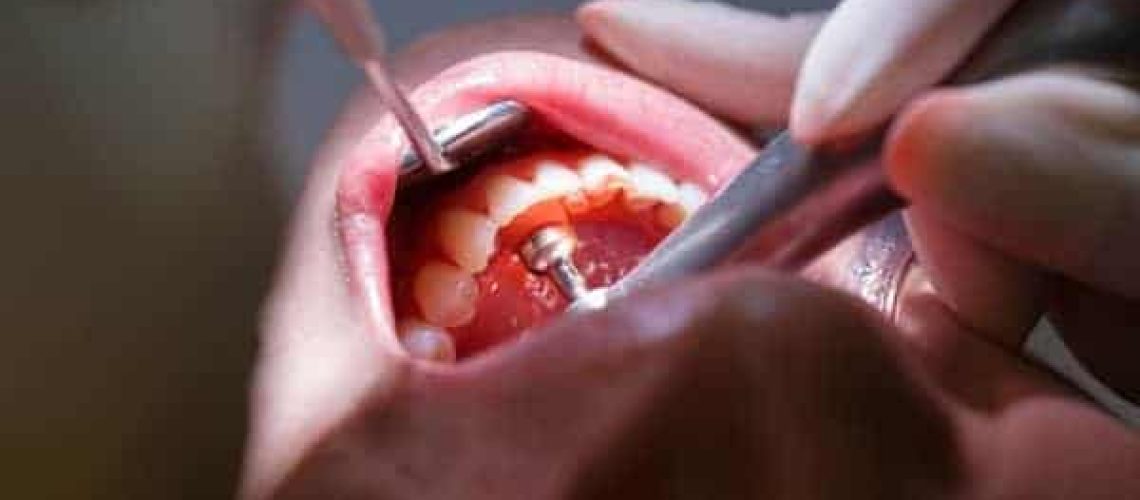What Is Periodontal Disease?
 Periodontal disease – also known simply as “gum disease” – is a painful inflammation of the gums due to an infection from the bacteria in plaque.
Periodontal disease – also known simply as “gum disease” – is a painful inflammation of the gums due to an infection from the bacteria in plaque.
If plaque is left to accumulate along the gumline, the body responds by releasing a hormone that causes the gums to become inflamed (this is one of the body’s many ways of protecting against infection and damage).
Periodontal disease begins in a relatively mild form called gingivitis. Symptoms include:
- Excessive bleeding when brushing your teeth
- Gum discoloration (usually red or purple)
- Persistent bad breath (halitosis)
- Slight gum sensitivity
Gingivitis can be reversed with improved dental hygiene, diet, and professional dental treatment. However, if the problem is not resolved, gingivitis will grow into an advanced form of gum disease called periodontitis.
 Unlike gingivitis, periodontitis is not reversible (although it is still treatable). This is also where things begin to get very painful. Symptoms include:
Unlike gingivitis, periodontitis is not reversible (although it is still treatable). This is also where things begin to get very painful. Symptoms include:
- Advanced recession of the gumline
- Loose and shifting teeth
- Severe bleeding when brushing
- Pain
- Tooth loss
How Is Periodontal Disease Treated? Can It Be Stopped?
As stated above, the early stage of periodontal disease – gingivitis – can be stopped. The latter stage – periodontitis – is irreversible, although it is still treatable.
Gingivitis Treatment
All of the plaque and tartar (plaque that has turned into a hard crust) is removed in a process known as “scaling”. As the name implies, this can be very uncomfortable, especially if there is extensive tartar build-up.
Your dentist will likely suggest follow-up appointments to monitor your gums and perform more cleanings to ensure the process is entirely reversed. Better oral hygiene habits will also be required to keep this from happening again.
Periodontitis Treatment
 While gingivitis treatment is non-surgical, the same can’t be said for periodontitis treatment – it requires more advanced procedures.
While gingivitis treatment is non-surgical, the same can’t be said for periodontitis treatment – it requires more advanced procedures.
- Flap surgery (pocket reduction surgery) – The periodontist cuts into a section of the gums and lifts it back to expose the tooth root, allowing him or her to perform deeper scaling.
- Soft tissue grafts – The gums recede from the teeth because the tissue has been lost (eaten away). A periodontist can remove some of the tissue from the roof of your mouth and graft it onto areas of the gums that are particularly recessed.
- Bone grafting – Periodontitis can destroy the jaw bone in areas surrounding tooth roots. Small fragments of bone – either your own bone, donated bone, or a synthetic bone-like material – can be grafted onto these areas.
- Guided tissue regeneration – Bone that is destroyed can be regrown with carefully placed biocompatible fabric, which prevents unwanted tissue (gum tissue) from forming on the area, allowing for bone growth instead.
- Tissue-stimulating proteins – This is a protein-rich gel that can be applied to a diseased tooth root; it stimulates healthy bone tissue growth.
Preventing Periodontal Disease
Periodontal disease occurs when plaque and tartar are left to fester on the gumline. Don’t let this happen.
The simple way to stop periodontal disease is to maintain good dental and oral hygiene. This includes brushing and flossing regularly – once in the morning and once at night – without skipping a day.






